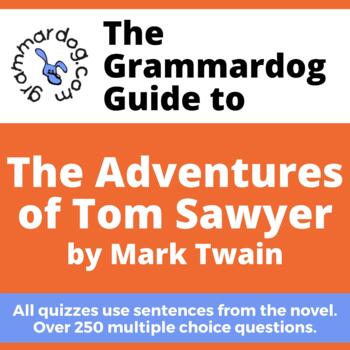Tom Sawyer by Mark Twain - Grammar Quiz
- Zip
Description
An Easy Way To Support and Check Analytical Thinking and Reading!
Perfect for Distance Learning or Homeschooling.
These multiple choice questions based on text sentences from Tom Sawyer by Mark Twain are excellent teaching tools, providing the basis for thoughtful, engaging activities for your students.
Grammardog Teacher's Guide contains 16 quizzes for this novel. All sentences are from the novel. Sensory imagery is characteristic of Realism: "the cracked bell of the small church began to ring" "she put her small hand upon his" "the fragrance of the blossoms filled the air" "the superintendent was a slim creature of thirty-five with a sandy goatee and short sandy hair" "a sumptuous breakfast of bacon and fish" "a bird called - another answered." Allusions include Robin Hood, Columbus, Richard III, George Washington.
This PDF downloadable Grammardog Guide for Tom Sawyer contains 16 analytical multiple choice quizzes with a total of over 250 questions covering:
- grammar
- proofreading
- sentence types
- figurative language
- literary devices
- imagery
- allusions & symbols
- theme
- and more--all directly related to the novel!
Grammardog Teacher's Guides are classroom reproducible.
Each guide includes an Answer Key, a Glossary of Grammar Terms and/or a Glossary of Literary Terms.
What is the best way to use a Grammardog Teacher's Guide?
Best practices include the following classroom use:
- As quizzes, tests and exams
- As a diagnostic tool for grammar, style, spelling, capitalization and punctuation
- As practice for state tests, AP tests, the ACT and SAT
- As a review of grammar, style and proofreading
- As an introduction to specific grammar elements, figurative language or literary devices
- As a springboard for class discussion of an author’s style
- As a tool for analyzing grammar and style in context
- As ready-made lessons for teaching how to write literary analysis
- As a tool to improve reading comprehension of challenging material such as Shakespeare plays, classic novels, essays and poetry
- As an easy way to compare different authors’ styles
- As a tool to get reluctant readers to engage the text in a book, short story, play, essay or poem


